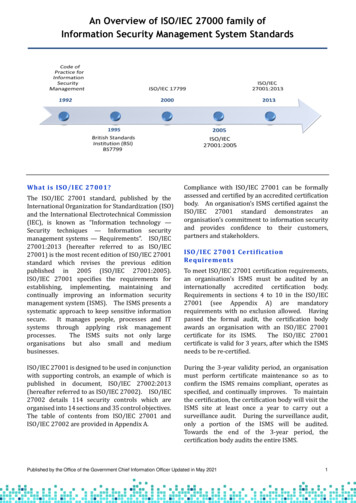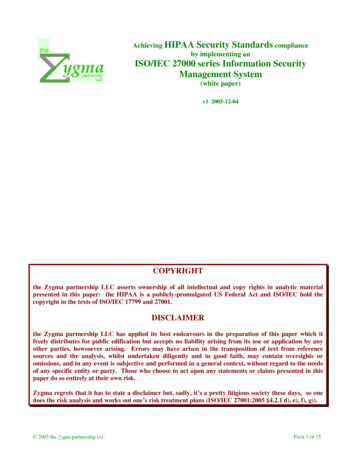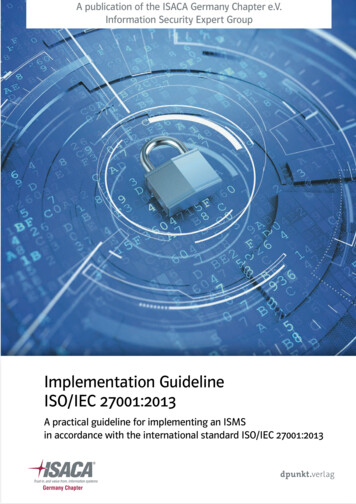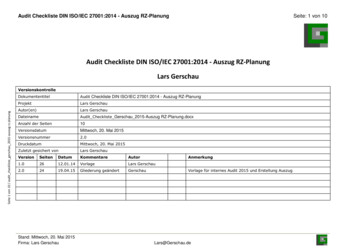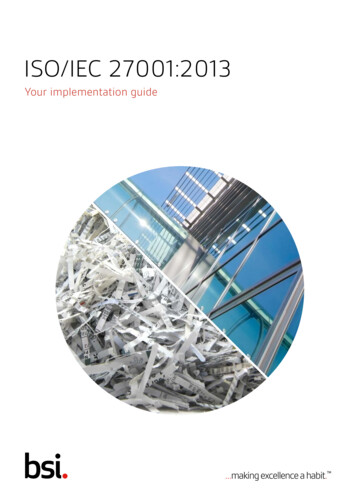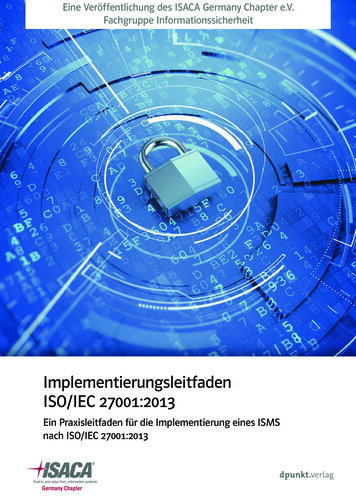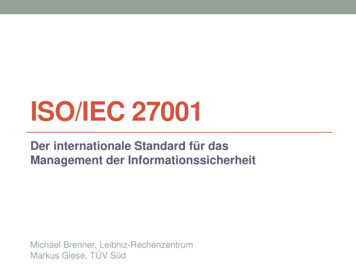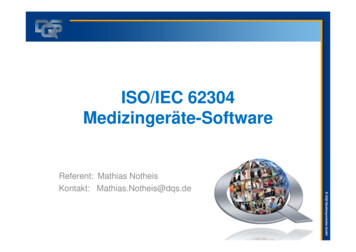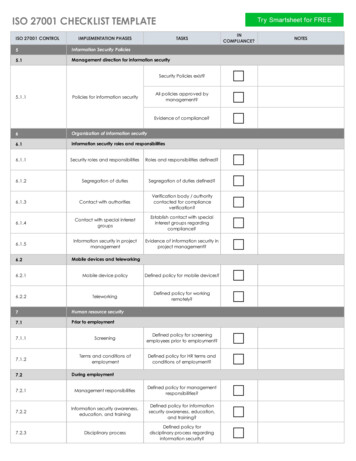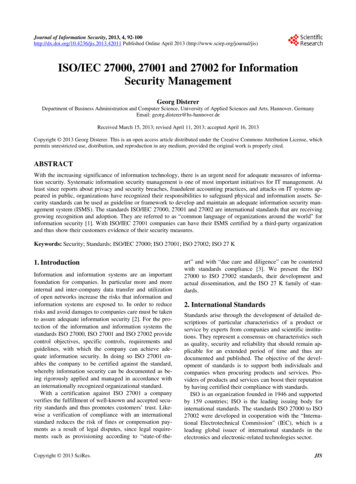
Transcription
Journal of Information Security, 2013, 4, 92-100http://dx.doi.org/10.4236/jis.2013.42011 Published Online April 2013 (http://www.scirp.org/journal/jis)ISO/IEC 27000, 27001 and 27002 for InformationSecurity ManagementGeorg DistererDepartment of Business Administration and Computer Science, University of Applied Sciences and Arts, Hannover, GermanyEmail: georg.disterer@hs-hannover.deReceived March 15, 2013; revised April 11, 2013; accepted April 16, 2013Copyright 2013 Georg Disterer. This is an open access article distributed under the Creative Commons Attribution License, whichpermits unrestricted use, distribution, and reproduction in any medium, provided the original work is properly cited.ABSTRACTWith the increasing significance of information technology, there is an urgent need for adequate measures of information security. Systematic information security management is one of most important initiatives for IT management. Atleast since reports about privacy and security breaches, fraudulent accounting practices, and attacks on IT systems appeared in public, organizations have recognized their responsibilities to safeguard physical and information assets. Security standards can be used as guideline or framework to develop and maintain an adequate information security management system (ISMS). The standards ISO/IEC 27000, 27001 and 27002 are international standards that are receivinggrowing recognition and adoption. They are referred to as “common language of organizations around the world” forinformation security [1]. With ISO/IEC 27001 companies can have their ISMS certified by a third-party organizationand thus show their customers evidence of their security measures.Keywords: Security; Standards; ISO/IEC 27000; ISO 27001; ISO 27002; ISO 27 K1. IntroductionInformation and information systems are an importantfoundation for companies. In particular more and moreinternal and inter-company data transfer and utilizationof open networks increase the risks that information andinformation systems are exposed to. In order to reducerisks and avoid damages to companies care must be takento assure adequate information security [2]. For the protection of the information and information systems thestandards ISO 27000, ISO 27001 and ISO 27002 providecontrol objectives, specific controls, requirements andguidelines, with which the company can achieve adequate information security. In doing so ISO 27001 enables the company to be certified against the standard,whereby information security can be documented as being rigorously applied and managed in accordance withan internationally recognized organizational standard.With a certification against ISO 27001 a companyverifies the fulfillment of well-known and accepted security standards and thus promotes customers’ trust. Likewise a verification of compliance with an internationalstandard reduces the risk of fines or compensation payments as a result of legal disputes, since legal requirements such as provisioning according to “state-of-theCopyright 2013 SciRes.art” and with “due care and diligence” can be counteredwith standards compliance [3]. We present the ISO27000 to ISO 27002 standards, their development andactual dissemination, and the ISO 27 K family of standards.2. International StandardsStandards arise through the development of detailed descriptions of particular characteristics of a product orservice by experts from companies and scientific institutions. They represent a consensus on characteristics suchas quality, security and reliability that should remain applicable for an extended period of time and thus aredocumented and published. The objective of the development of standards is to support both individuals andcompanies when procuring products and services. Providers of products and services can boost their reputationby having certified their compliance with standards.ISO is an organization founded in 1946 and supportedby 159 countries; ISO is the leading issuing body forinternational standards. The standards ISO 27000 to ISO27002 were developed in cooperation with the “International Electrotechnical Commission” (IEC), which is aleading global issuer of international standards in theelectronics and electronic-related technologies sector.JIS
G. DISTERER93Figure 1. Development of standards ISO 27000, ISO 27001, and ISO 27002.3. Development and Dissemination of ISO27000 to ISO 27002 Standards3.1. Development of StandardsThe existence of the ISO 27000 to ISO 27002 standardscan be traced back to 1993 (Figure 1), whereby a Britishprofessional association, the National Computing Centre(NCC), published a document titled “PD 0003 A Code ofPractice for Information Security Management”. TheBritish Standards Institute (BSI) adopted this and issued“BS 7799-1 IT—Security techniques—Code of practicefor information security management” as national standard in 1995.The complementary part “BS 7799-2 Information security management systems—Specification with guidance for use” enables companies to certificate their processes. ISO harmonized this standard with others like ISO9001 and developed the ISO 27001 in October 2005.Since then, companies can certify their processes according to this international standard.ISO 27001 formed the foundation for the ISO 27 Kfamily of standards, which encompass various standardsfor information security. In 2007 the old ISO 17799standard was assigned to the ISO 27 K family as ISO27002. In 2009 ISO 27000 was issued to provide anoverview, introduction and explanation of terminologywith the title “IT—Security techniques—Information security management systems—Overview and Vocabulary”.3.2. Current Dissemination of ISO 27001CertificationAt the end of year 2010 worldwide 15.625 certificatesaccording to ISO 27001 are valid [4], more recent andreliable information do not exist. Figure 2 shows thedevelopment from 2006 to 2010 and the large increase inCopyright 2013 SciRes.the dissemination. With the high number of certificates in2006 it should be noted that organizations that held certificates according to prior standards were able to convertthese to ISO 27001 in a simplified process.All our figures show the number of certificates according to ISO 27001, not the number of certified organizations. The number of organizations holding certificates cannot be given, because some organizations dohave several certificates, e.g. for several sites or groups,other organizations do have one certificates for severalsites.The distribution of the certificates issued per region isshown in Figure 3. Alone 6.264 certificates were registered in Japan caused by local national legislations inJapan that often require the submission of proof or verification of security management conformance with standards. Furthermore, the surprisingly high number of certificates in Asia aside from Japan can be explained inpart as follows: One objective of companies in Europeand North America is cost reduction through outsourcingof IT services. IT providers in Asia strive to achieve thisobjective primarily through the utilization of lower personnel costs. However, these providers are largely unknown in Europe and North America and have neitherimage nor reputation. Managers who are heading to outsource some of their IT activities need confidence in thereliability and professionalism of Asian IT providers.Normally they try to secure this by detailed and costlycontracts and agreements, verifications, assessments, andreviews [5].Independent attestations of the providers can be supportive and reinforcing. With a certificate according toISO 27001 IT providers can thus document the conformity of their security processes with a recognized standard. The certificate serves as verification from an independent body and provides sureness about appropriatesecurity measures; it serves as quality seal increasing theJIS
94G. DISTERERFigure 2. Number of certificates accord. ISO 27001 [4].Table 1. Number of certificates [4].Top Countries in 2010Figure 3. Number of certificates accord. ISO 27001 by regions [4].competitiveness of an IT provider [6].The low number of 329 certificates registered in NorthAmerica confirms the common assumption that international IT standards do not currently draw much attentionthere [7]. In Europe ISO 27001 has been widely disseminated, many European countries are in the list givenin Table 1. The high number of certificates in the UKcan also be explained by the fact that a British standardwas the basis for the international ISO 27001 standardand so there is a longer tradition of certification according to security standards.4. ISO 27000The ISO 27000 standard was issued in 2009 to providean overview for the ISO 27 K family of standards and acommon conceptual foundation [8]. 46 basic informationsecurity terms are defined and differentiated in the“Terms and conditions” section. The meaning of information security and systematic engagement with securityCopyright 2013 SciRes.Japan6.264India1.281United Kingdom1.157Taipei1.028China957Spain711Czech Republic529Italy374Germany357Romania350aspects is derived from the risk for companies whosebusiness processes are increasingly dependent on information processing and whose complex and interlinked ITinfrastructures are vulnerable to failures and disruptions.As with other IT standards, the ISO 27 K family of standards refer directly to the “Plan-Do-Check-Act” (PDCAcycle) cycle—well known from Deming’s classic qualitymanagement (Figure 4), which emphasizes the necessityof process orientation as well as integration of the planning of operations and the constant checking of planing-compliant implementation [6].In the planning phase for an ISMS the requirementsfor protection of the information and the informationsystems will be defined, risks identified and evaluated,and suitable procedures and measures for reducing risksdeveloped. These procedures and measures will be implemented during implementation and operations. Thereports generated through continuous monitoring of operations will be used to derive improvements and forfurther development of the ISMS.JIS
G. DISTERER95Figure 4. PDCA cycle in ISO 27000 [9].5. ISO 270015.1. ContentThe ISO 27001 standard was published in 2005 under thetitle “Information technology—Security techniques—Information security management systems—Requirements”. In 42 pages it describes the requirements that anISMS must fulfill in order to achieve certification. As aframework, the standard is aimed at companies from allsectors and of all sizes. However, there is some doubtover the suitability for SMEs [10]. Concrete measures forthe fulfillment of requirements are not be stipulated bythe standard but rather must be developed and implemented on a company-specific basis. Certification requirements of ISO 27001 are elucidated through theelaboration of terms and concepts and supplemented witha implementation guideline within ISO 27002.The focal point of ISO 27001 is the requirement forplanning, implementation, operation and continuous monitoring and improving of a process-oriented ISMS. Theapproach should be aligned with the PDCA cycle (Figure 4). The coverage and scope of an ISMS should bedefined for planning and implementation. Risks shouldbe identified and assessed [8] and control objectivesshould be defined for the information and informationsystems. Suitable measures for protecting operationsshould be derived from these. In annex A of the standarda total of 39 control objectives and 134 measures for security management are listed and thus expressly stipulated. The control objectives are listed in Table 2, subdivided by domains. These are described further and de-Copyright 2013 SciRes.tailed in the ISO 27002 standard [11].Adequate training should be developed for the implementation in order to push though the stipulated procedures and to establish them, and to generate awareness oftheir necessity [8]. The compliance with the proceduresmust be continuously monitored. The measures should bechecked and improved in the course of continuous improvement and security risks should be identified andassessed in order to continuously increase the effectiveness and efficiency of the ISMS [8].Requirements, which are to be applied to the ISMSdocumentation, are described in the standard through thestipulation of essential content, necessary documents aswell as specifications and monitoring structures fordocument management, such as: Change and approvals processes Version control Rules for access rights and access protection Specifications for filing systems [8]Responsibilities of top management in all phases ofthe PDCA cycle are listed [8]. They encompass determination and implementation of a security policy, the definition of roles and responsibilities, the recruitment andpreparation of necessary personnel and material resources as well as decisions on risks management.The improvement and further development of theISMS is to be implemented continuously, based on thesecurity policy, the logging and evaluation of operations,the results of testing as well as the results from improvement measures. In addition the improvement andfurther development should be pushed forward throughJIS
G. DISTERER96Table 2. ISO 27001 control objectives [8].DomainSecurity policyOrganization ofinformation securityAsset managementControl objectivesTo provide management direction and support for information security in accordance with businessrequirements and relevant laws and regulations.To manage information security within the organization.To maintain the security of the organization’s information and information processing facilitiesthat are accessed, processed, communicated to, or managed by external parties.To achieve and maintain appropriate protection of organizational assets.To ensure that information receives an appropriate level of protection.Human resourcessecurityPhysical andenvironmental securityTo ensure that employees, contractors and third p
a implementation guideline within ISO 27002. The focal point of ISO 27001 is the requirement for planning, implementation, operation and continuous mo- nitoring and improving of a process-oriented ISMS. The approach should be aligned with the PDCA cycle (Fig- ure 4). The coverage and scope of an ISMS should be defined for planning and implementation. Risks should be identified and assessed [8 .

